Port of Plymouth, England
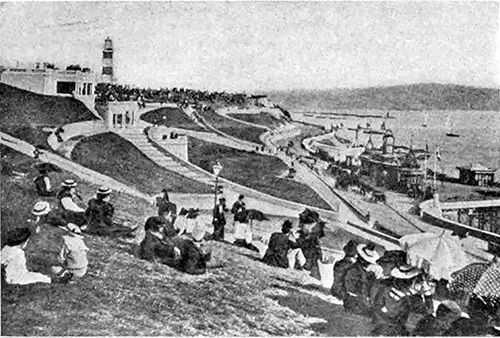
The Promenade Overlooking the Harbor at Plymouth, England. GGA Image ID # 143203e419
Plymouth - Its advantage as a landing place and the attractiveness of the surrounding country, rapidly becoming the most important recreation ground in England, are bringing to it a degree of prominence in American thought scarcely second to that which Southampton has attained.
ENGLISH RAILWAY CONNECTIONS
Upon arrival in Great Britain, tourists are greeted by the convenience of the Great Western Railway or the Southwestern. These efficient railway systems offer special steamer trains that whisk you to London in a mere 4 1/2 hours, making your journey a breeze.
For the comfort and safety of solo female travelers, these trains often provide a 'traveling lady's attendant'. This thoughtful service is just one example of how Plymouth has become a significant port of call for steamers from all German lines, and most English lines except the Cunard.
The White Star still sends ships to Liverpool, but others of this line, and some of the most important, stop at Plymouth on their way to Southampton. This season, it was announced that the Holland-American Line, which operates a fleet of fine large ships, including the Rotterdam, with a displacement of 37,190 tons, now calls at Plymouth with its two ships, Rotterdam and New Amsterdam, on their east-bound Voyages. The French port of call for this line remains Boulogne-Sur-Mer.
The Great Western Railway, one of England's largest systems, spans nearly 3,000 miles of picturesque landscapes in England and Wales. Its various lines lead to fourteen cathedral cities, promising a journey filled with cultural and historical discoveries.
Stratford and Fishguard, the new port of the Cunard line, may also be reached. From Fishguard, Ireland is reached by a route shorter than others. Turbine steamers owned by this company, 350 feet long and making 22 1/2 knots an hour, operate from Fishguard by day and night.
The London and Northwestern Railway penetrates the heart of England, with branch lines to Wales and, in connection with the Caledonian Railway, to Scotland as far north as Aberdeen.
It runs directly to Holyhead and Liverpool, Warwickshire, and Wordsworth country (otherwise known as the Lake District), the country in which the ancestors of Washington and Franklin lived.
Illustrated pamphlets, descriptive of these localities, are issued by the company and may be had at its agency, 237 Fifth Ave., New York. In Warwickshire, the company maintains a motor car service by which one may visit Stratford, Warwick, and Kenilworth at a moderate charge.
The Midland Railway, one of the country's great lines, passes through central England. The Great Eastern from London takes one to many of the most famous English cathedrals, including Ely, Peterborough, Lincoln, and Norwich.
By this line, one reaches Hull and Newcastle, where steamers are taken for Norway. It also goes to Harwich, whence steamers run to the Hook of Holland. By this route, that part of eastern England from which came the Pilgrim Fathers is accessible.
PLYMOUTH, ENGLAND (1905)
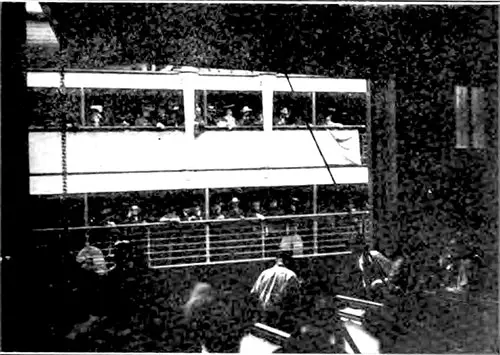
Cabin Passengers Waiting for the Gang Plank to be Lowered at Plymouth. GGA Image ID # 1431ca35c5
An Attractive Port of Entry for American Travelers to England and the Port of North German Lloyd Steamers.
As Plymouth is the English haven from which the Mayflower set sail in 1620, on its memorable voyage to New England, it has always had a claim upon the United States.
Its advantage as a landing place and the attractiveness of the surrounding country, rapidly becoming the most important recreation ground in England, are bringing to it a degree of prominence in American thought scarcely second to that which Southampton has attained.
The trend of English fashion these past few years has been toward the two southwest counties generally known. The diversified beauty of the long stretch of seacoast from Southampton to Land's End and back to Bristol and the rugged interior filled with sightly "tors," picturesque gullies, and delightful reminiscences of the Arthurian legends, Lorna Doone and Conan Doyle, has proved a greater and greater attraction to well-to-do Britishers and to the members of the American colony in London.
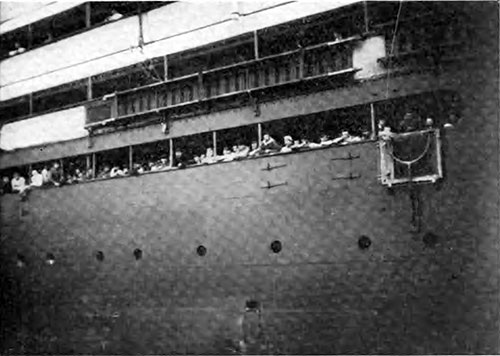
Common Sight at Plymouth - Seeing the Firemen and Coal Passers Cooling Off at the Rail. GGA Image ID # 1431df85ef
As a rule the fashion of summering, both in England and in America, is first set by artists. Just as the landscape painters first discovered Newport, Bar Harbor, and the Berkshires, to be followed later by the wealthy and fashionable families of New York, Boston, and Chicago, so the district of Devonshire is at present passing through a stage of popularity with the artists, and with the class of people whom art most easily influences.
Covely, for instance, a picturesque little place on the north shore of Evon has of late become distinctly a fad of both British and American painters, and along either coast, whether about Exeter of Plymouth to the south, or Ilfracombe, Bude, or Tintagel on the north, you will always see white umbrellas. The whole region is full of the subjects that the early English artists affected.
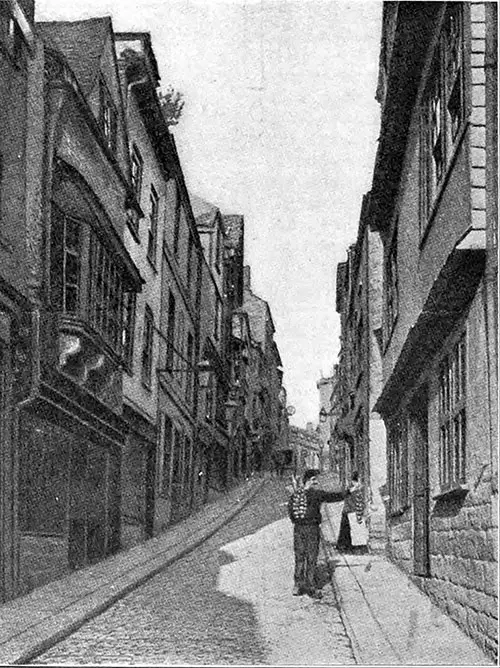
View of Old Houses in Plymouth, England. GGA Image ID # 143202fec3
Here, Sir Joshua Reynolds was born and worked during portions of his life, and here, the greatest of all London landscapists, Turner, painted many pictures, among them the famous "Devonport," which has lately been acquired by the Fogg Museum at Harvard University.
Plymouth is the natural gateway for Americans to the Devonshire countryside. As an introduction to England, it is like beginning one's meal with dessert, but perhaps there is an advantage in seeing the best first.
The similarity of Old Plymouth to the Massachusetts town that bears its name and to which thousands of American tourists go every year will perhaps be one of the entertaining features for many travelers who approach it from the sea.
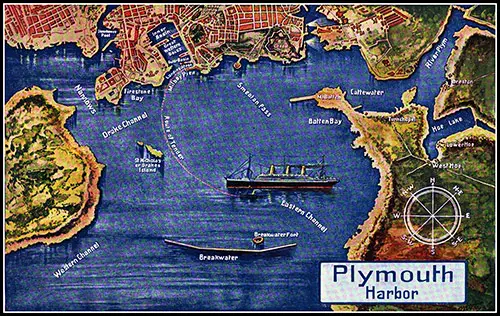
Map of Plymouth Harbor Shoring Route of Tender Used by the Steamship Lines. Hamburg-American Line, Summer 1913 Edition, p. 189. GGA Image ID # 1d1e99b298
To be sure, the American Plymouth, a little village of 10,000 people, is quite outclassed by this large center, which numbers a quarter of a million people in the neighborhood, but there are certain striking resemblances.
Just as the vessel in making the harbor of the American Plymouth first passes a great lighthouse and then comes within a natural breakwater into a closed harbor, so the Norddeutscher Lloyd steamship goes past the Eddystone Light, to glide into smooth water behind the artificial stone breakwater, which has made this harbor one of the safest in the world.
The great promenade alone The Hoe, Plymouth's park situated on a plateau overlooking the sea, suggests the boulevard extending southward from the American Plymouth; over and beyond are forested heights not unlike those of Manomet.
The country beyond is less well-wooded than that of eastern Massachusetts, and the hills are higher, but there is still a general resemblance.
If the American tourist has not followed the industrial development of towns in southern England, he is apt to be surprised to discover that this community, composed of the three adjoining cities of Plymouth, Stonehouse, and Devonport, has an aggregate population of more than 200,000 supported mainly by shipping and small manufacturing.
He discovers a modern city with a fine free public library and several other libraries connected to literary and scientific institutions, a municipal museum, and flourishing art and technical schools.
There are also plenty of theaters and music halls, one of which, the Theater Royal, is prominent among the world's great theaters.
During the entire season, the city is full of visitors coming and going, departing on coaching trips to Dartmoor or on sea and river excursions up and down the Devon and Cornish coasts and up the many rivers that run into the English Channel.
There is abundant bathing close to the town, and the open-air concerts are among the best in England. Those who had thought of Brighton as the only great English watering place find the magnitude of Plymouth rather staggering.
The fact that the American tourist learns a great deal of ancient history in Plymouth goes without saying. He discovers that, although the town is one of the oldest places along the coast, being known as late as the reign of Henry II as ''a mere thing as a habitation for fishers," its favored situation caused it to be built up rapidly during the years when the English naval and merchant marines were first being developed to great proportions.
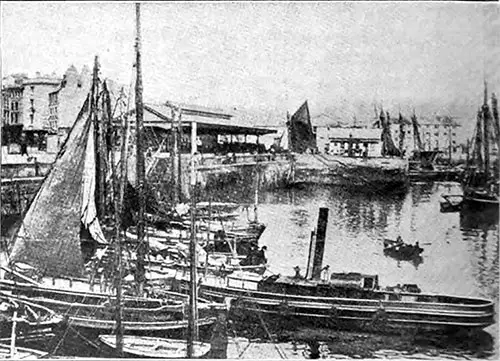
Fishing Boats at the Quay of Plymouth, England. GGA Image ID # 1432240d1c
Situated where the Plym and four other rivers come together, it has an admirable harbor, and it early became an object of frequent attacks from the French, who although generally repulsed, met with occasional success and caused Henry II to fortify the entire coast.
In Queen Elizabeth's reign, we read about such doughty Britons as Sir Humphrey Gilbert, Sir Francis Drake, Sir Walter Raleigh, Sir Thomas Cavendish, Sir John Hawkins, Sir Martin Frobisher, and Lord Howard, together with countless other heroes of the sea, in connection with Plymouth.
Among the noteworthy events in which Plymouth has participated, probably the most famous was the gathering of her sailor sons on the famous Hoe on that glorious July afternoon in 1588, when the invincible Armada was in sight.
Eight years later, 130 ships were assembled again at Plymouth, which sailed after the successful attack on Cadiz, led by the Earl of Essex.
Again in 1620 the Pilgrim fathers, after a long stay in Plymouth, during which they gave up one of their ships, the Speedwell, set sail in the Mayflower to find in the new world the homes they had lost in the old, and to become the founders of the greatest republic witnessed by the 20th century.
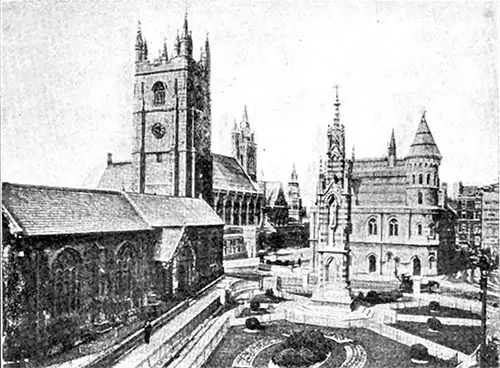
Group of Public Edifices in Modern Plymouth, England. GGA Image ID # 143270b43b
Hence, too, Cook and Vancouver started forth on their ocean voyages; and to Plymouth in 1815 came the Bellerophon, bearing on board Napoleon Bonaparte, defeated and captured. In general Plymouth has been but very little connected with military affairs, save at the time of the great Civil War, when it was held and retained by the Parliament, although it suffered some long and very severe sieges from the Royalists.
Plymouth occupies a very important position from a commercial point of view and has a large coastwise and Mediterranean trade. The value of its harbor is dependent upon its celebrated breakwater, a giant work slighted by the great Earl of St. Vincent. It was begun in 1812 and completed in about thirty years.
The huge stone pier, extending to a length of 5,100 feet and estimated to contain nearly 7,000,000 tons of stone, cost about $10,000,000. Some fourteen miles out to sea rises the new Eddystone Lighthouse to a height of 133 feet.
It was constructed of 2,171 blocks of granite under the direction of Sir J. N. Douglas. Its lantern exhibits a flashing light visible seventeen and a half miles a fixed light on the lower level marking the Long Deeps.
During foggy weather, a bell is sounded twice at intervals of half a minute. Since the completion of the light and breakwater, Plymouth has always been considered one of the safest harbors on the globe—a fact that will satisfy the thousands of American travelers who are destined to land at its quays.
Ocean Mail and Passenger Traffic
During 1901, there was a shipment of sacks of mail to Plymouth from New York, with a value of £1,015,315, 2,928 passengers, and 17,764 sacks of mail. The outward steamers embarked 604 passengers. The following, regarding Plymouth as a port of call, is from the. Western Daily Mercury:
The year 1901 was generally satisfactory for Plymouth as a port of call. Some 444 ocean mail and passenger steamers touched at the port, compared with 421 vessels in 1900.
The outward-bound steamers numbered 102, as against 95, and the homeward-bound 342, as against 326. The number of passengers handled slightly increased, principally due to more Atlantic traffic.
1901 was not without some changes, the most important undoubtedly being the return of the Norddeutscher Lloyd Company's express steamers, engaged in the trans-Atlantic trade.
The German Lloyd Company, after a very brief connection with the port, reverted to Southampton at the time of the Spanish-American war, and the resumption of their relationship with Plymouth at the very end of the passenger season was certainly unexpected.
The brilliant performances of the Hamburg-American Company's record holder, the Deutschland, had directed attention to the port, with the result that the Kronprinz Wilhelm, on her maiden voyage, called at Plymouth in October last.
Since then, the express steamers of the line have regularly called at Plymouth and are advertised to do so next passenger season. Attention has already teen called in the columns of the Western Daily Mercury to the large numbers of passengers that have been dealt with at Plymouth by the Hamburg-American Line.
Outward and homeward, the large intermediate steamers have called at Plymouth, while on the eastward journey, the express steamers regularly called to land mail, passengers, and freight.
According to the present arrangement, the express service, which was suspended for the winter in December, will be resumed by the SS Columbia, which is due at Plymouth on March 15th.
The slower vessels, the Pennsylvania, the Patricia, the Pretoria, and the Graf Waldersee, maintain their service throughout the year, and they are still calling at Plymouth, both outward and homeward.
After March next, the service will be augmented by the inclusion of two new large steamers, the Moltke and the Blucher. Up to the present, the Hamburg-American Company's steamers have sailed from Plymouth on Tuesdays, but in the future, the sailing day will be Monday.
One line, the Woermann Line, which is engaged in the West African trade, has withdrawn from Plymouth during the past year. In March last, it was announced that these steamers would call at Plymouth outward as well as homeward, but a month or two later, they signified their intention of making Southampton their English port, and in July, their connection with Plymouth ceased. Messrs. Elder, Dempster & Co., of Liverpool, have improved their service between the west coast of Africa and Plymouth, and now three of their steamers touch at the port monthly, instead of two, as formerly.
Hamburg-American Line Abandons the Port of Plymouth
It is rumored that the express steamers of the Hamburg-American I.inc will desert Plymouth, England, in favor of Southampton as a port of call, the change to take place early in spring. - (Marine Review, Vol. 39, No. 2, 14 January 1909, p. 29.)
Sailing Schedules that Include the Port of Plymouth, England
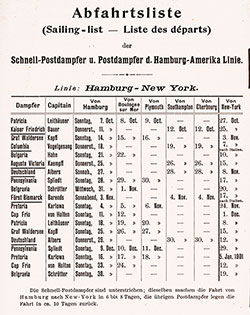
Hamburg American Line (HAPAG) Sailing Schedule, 7 October 1900 to 19 January 1901
Steamers and Ocean Liners operated by the Hamburg Amerika Linie / Hamburg American Line (HAPAG) were scheduled for transatlantic voyages between 7 October 1900 and 19 January 1901.
Bibliography
"English Railway Connections," in The Literary Digest, New York: Funk & Wagnalls Company, Vol. XLII, No. 15, Whole No. 1095, 15 April 1911, p. 763.
"Plymouth, England," in the North German Lloyd Bulletin, New York-Bremen: Norddeutcher Lloyd, Vol. XIX, No. 1, January 1905, p. 1-3.
Joseph G. Stephens, Consul. "Ocean Mail and Passenger Traffic," in Commercial Relations of the United States with Foreign Countries During The Year 1901, Washington: US Government Printing Office, Volume II, 12 February 1902, p.890-891.
